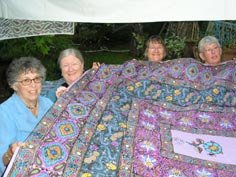|
9/8/05 Day 2:
City was
surrounded by protective walls until 1453 Visited the underground Basilica
Cistern built 1,500 B.C. Amazingly large (143 m x 65 m wide). Held clear
clean water due to the pebbles on the roof which removed the dirt before the
water dripped down. Fish could live in the water. Sun dried bricks on the
ceiling with spiral in each center. Iron bars across the roof. People lived
underground to protect the water supply. Was used until early 1900s when
electric pumps replaced it and brought water in and kept it at a specific
mark.. In the 1960s, lovers rented boats with lanterns to traverse it.
Earlham College performed there with Meli’s assistance.
 Saw a sculpture of Medusa who was a Gorgon, Greek and Anatolian deity). She
represented all people but had blue eyes which were put on to the hand of
Fatima to ward off evil. Christianity took the blue eye which became the
form of the fish which represents Jesus Christ. Islam also uses the blue eye
for the name of its biggest insurance company.Turkish
Islamic Art Museum (with beautiful 13th c wooden door) gave us a
first introduction to old carpets, calligraphy, brass and wood work with
mother of pearl decoration. I especially enjoyed the Black Tent dwellers
represented by dioramas downstairs. ,The Karaevli Toruk tribe (20,000) live
in goat felt tents which are impenetrable to bullets, cold air, hot air,
etc. women lead the caravans, pick the new locations, set up tents, cook,
take care of children, etc (matriarchal).You could see the change in
clothing as one’s income progressed. Interesting that while Turkey has
diversity, Meli says, there is no class structure based on money.Turkish
baths are places to exchange gossip, show off eligible young women who wear
embroidered towels.
Saw a sculpture of Medusa who was a Gorgon, Greek and Anatolian deity). She
represented all people but had blue eyes which were put on to the hand of
Fatima to ward off evil. Christianity took the blue eye which became the
form of the fish which represents Jesus Christ. Islam also uses the blue eye
for the name of its biggest insurance company.Turkish
Islamic Art Museum (with beautiful 13th c wooden door) gave us a
first introduction to old carpets, calligraphy, brass and wood work with
mother of pearl decoration. I especially enjoyed the Black Tent dwellers
represented by dioramas downstairs. ,The Karaevli Toruk tribe (20,000) live
in goat felt tents which are impenetrable to bullets, cold air, hot air,
etc. women lead the caravans, pick the new locations, set up tents, cook,
take care of children, etc (matriarchal).You could see the change in
clothing as one’s income progressed. Interesting that while Turkey has
diversity, Meli says, there is no class structure based on money.Turkish
baths are places to exchange gossip, show off eligible young women who wear
embroidered towels.
Meli’s
talk in the museum’s interior café:
A
“stadium” is a Roman measurement. Hippodrome is an oval shaped structure.
Istanbul
combines east and west: Corinthian, Byzantine, Greek and Asian cultures.
Served as the capitol for 3 continents (Roman, Byzantine and Ottoman).
Europa was named after Zeus’ consort who was turned into a cow with a fly on
its tail by his jealous wife, Hera. Europa fell and became the Bosphorus.
“40”
symbolizes many; not a specific number
“72”
means many like the number of nations in the UN
“101”
means innumerable
Istanbul
is like a very old woman who wants to look like her prime. Sometimes she is
messed up as with an older person who has wonderful treasurers.
When
Christianity was the state religion, buildings were dedicated to Greek
deities. The Basilica was built on the Temple of Apollo with pillars on top.
The Temple of Athena had pillars with Doric capitals. Istanbul is on an
earthquake line.
Turkish
people are not Middle Easterners, nor are Semitic and are not European or
Central Asian. They are a synthesis of all of these. Calligraphy was
developed by Arabs but perfected in Turkey.
North is
the Black Sea; south is the Mediterranean; bordered with Iraq, Iran, Syria,
Armenia, Georgia, Thrace, Greece, Bulgaria, etc. Turkey is called: 1) Asia
Minor and 2) Anatolia (Greek word) which is “land where sun rises” and
symbolizes happiness, creativity, hope and confidence. Tolia means full of;
ana/anne refers to mother. Turkey as the currently defined country came into
being in 1923.
History
of Turkey:
Developed
in waves with peaks (Empires) and valleys (city states and kingdoms)
Began as
a city state around 5,000 BC. The Byzars came from Macedonia. Had dreamt
that 3 Goddesses could be king of pre-Istanbul. Built a wall across the
Marmaras realizing the importance of the location at the tip of the
peninsula of the Bosphorus. Homer from Smyrna, had described Jason’s trip
through the rocks which ate people (the Bosphorus). Local people set up a
toll charge for those seeking a passage through the Bosphorus.
The
Persian Empire had dreamed of taking Anatolia. Solders on horses came. Their
leader, Darius, did not know how to cross the Bosphorus. His engineers made
a marble pontoon bridge (560 BC). “If you cannot break a hand, you can shake
it” was the saying in early Istanbul so that the soldiers were greeted by
well dressed denizens of Byzas who offered them a percentage of their toll
income in return for autonomy. One hundred years later, Greece took over
from the Persians (celebrated by the marathon). The area returned to be a
city state for over 100 years. A young Macedonian (Alexander) who had
studied history dreamed of conquering land to India. He too was greeted by
well dressed Byzas who doubled the tax that they had given to Darius in
return for being left alone. Alexander died at 33 years old and his Empire
was divided by his generals. The area reverted to being a city state until
about 50 BC when the Roman Empire (Caesar) wanted Anatolia. Sent engineers
in advance to build a pontoon bridge. “I came, I saw, I conquered” in
Anatolia. Byzas owed Caesar triple tax . About 200 years later, emperors
were weak and tribes from the north (Visigoths), Attila the Huns, etc.
attacked. Decided to elect a leader in Rome. There were 4 nominees saying
the same thing. Only one did not have a disability – Constantine. He was
elected and decided to find a new capitol which was Byzas and called it Nea
Roma. Built a 100,000 hippodrome. The capitol was renamed Constantinople.
His son, Theodocius inherited his Empire. In AD 390 the Roman Empire was
divided in two – the western portion was poor and corrupt. The eastern half
was called Byzantium or home of the Bzyas. The Crusaders invaded. In 1453,
the Turks made Istanbul the capitol of the Ottoman Empire which lasted until
1923.
Turks ran
the Secukulu Empire from what is present day Iran.
Around
1200, abuses of the Catholic Church during the Middle Ages. Brought Turkish
tile working to the eastern part of the Empire. Genghis Khan from Mongolia
conquered the crumbling Turkish empire. Andolu Selcuklulari headed the
Ottoman Empire which ruled north Africa, Middle East, Czech, Hungary, Iraq,
part of Iran, etc. The kitchen at the Tokapi Palace served 5,000 per day.
Lunch
nearby at a cafeteria . We had stuffed meat tomato, yogurt drink and crème
caramel.
Visited
Hagia Sophia, the 6th c.
. It is
built of marble (word comes from the ancient Greek word for Marmara Sea). It
is dedicated to the wisdom of Jesus not to any St. Sophia. The name is
another mangling by the British of Turkish. Cannot name a church after
someone unless they had lived in that area. Syncretism is evident by the
Greek Ionic column heads, Helenic large marble urns made during Alexander
the Great’s time and 8 red pillars came from a big Pagan temple for Artemus.
It was originally a church; then a Muslim temple and then a museum by decree
of Ataturk. Basilicas preceded churches. The Hagia Sophia was the first and
was made as an expression of God. The dome (the seat of god) is vertical not
horizontal. Justin told a dream to 100,000 people in the Hippodrome. He said
that Gabriel promised a bag of gold each day to those who would help built
the church. Four teams competing from different sides of the structure began
in 532 AD. The emperor did not live to see its completion 5 years later.
850 AD
the Ecumenical Council banned icons so none were worshipped. This was called
the “iconoclastic” era (where we get the word we use today). Saint
worshipping returned to the Byzantine Empire with Emperor Leo. Split in 1058
between the Roman Catholic west and the Roman Orthodox east. From 1206-1124,
removed the gold and silver candle holders and chandeliers and removed the
icons. Byzantine retook Istanbul. May 28, 1453 conquered Istanbul but did
not destroy the church. Converted it into a mosque. In 1934, Ataturk made it
into a museum. Real name is Hagia Sophia (
In Islam,
no images of humans. Carpets are not considered “art”. Babies are born on
carpets and are wrapped in them. People are buried in a carpet.
Ottoman
came from a man named Ausman who ruled a city state. The British said
Otto+man which became Ottoman.
Culture
is a factor of religion and religion is a factor of culture.
What
Anatolians do not tolerate:
1) People
describing Turkey as a dessert
2) being
called Arabs
3) not
being recognized for having introduced the Dutch to the tulip which you can
see in Turkey in March & April (the Dutch brought tiles to Turkey)
Meli’s
family in 1400 were Jews in Spain. Jews were given the choice of being Dutch
or Ottoman.
Went with
Kelly to look at rugs and learned that in Turkey, they use a two-knot
system, unlike in Iran which is only one knot. We were offered the first of
many hot apple tea served in small glasses.
Dinner in the
Kumkapi district at a fish restaurant near the water. Others nearby had
tourists but ours had mostly Turks (A deliberate act by Meli to insure that
we tasted real Turkish food). Loved green seaweed and sour crème appetizer.
|
![]()
